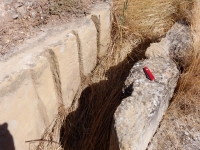
| For the photo's, see below |
| Home / the complete website |
"The aqueduct of Alcanadre is part of a very ambitious work, whose unknown designer did not hesitate to go to the left bank of the Ebro to catch the
flows and the level needed at the right bank."

|
| View on the NW side of the sluice gate. The first and third groove were intended for wooden planks to regulate the water flow; the middle, smaller grooves probably hold a filter screen. |
TechnicalitiesChannel before the bridge- Width on the bottom 2,52m - Width on the top 2,99m - Maximum height 1,18m - Estimated water level 0,90m |
The bridge in numbers - Estimated number of arches 118 - Of which still standing 11 - Length of the bridge 600m - Width of the specus on top 1,82m - Width of the parapets 0,59m |
The support of the bridge - Span of the arches 4,44m - Width of the pillars 1,10m - Width of the structure 2,99m From: Leather 2002 |
But the ancient channel ran to a quite higher level, so it would have dominated areas that Canal of Lodosa (total length is 127 km; the flow rate in the channel is 29 m 3/s)
cannot serve by gravity".
"The remains of the aqueduct south of the Ebro were affected by the construction in 1863 of the railway Calahorra via Alcanadre to Logrono, that describes here
a closed curve, sandwiched between the Ebro and the escarpment on the right bank.
Archaeological findings in different sections of the aqueduct, which followed a path substantially parallel to that adopted later on for the railway, were published in
Mezquiriz (1979)".
Wilke D. Schram
Mainly based on the relevant text of the Heliopolis / Lirgua website (Jose-Carlos Abadia Donaque) with alterations and supplements.
| Item | Info |
|---|---|
| Length | Unknown |
| Width on bridge | 1,82 m |
| Volume | Unknown |
| Gradient | Unknown |
| Period | post-Roman |
| Features | Sluice gate (plus filter?) in branch |
| Recommended literature : |
|
| Recommended websites : |
|
| How to visit : |
A part of the channel, the sluicegate, and the main part of the aqueduct bridge can easily be found 3km west of Lodosa along the NA-134 from Lodosa to Mendavia. The southern / right abutment of the aqueduct bridge on the other side of the river Ebro, can be found taking the dirt road at right from the roundabout just outside Lodosa at the right bank of the Ebro river. When you reach the Canal of Lodosa, take one of the bridges, follow the canal and at the end of the road park your car / bike there. Take the tunnel under the railways and turn right. Coordinates: 42 24 59N, 02 06 18W |
| HOME | More literature on more aqueducts | Last modified: November, 2016 - (webmaster) |